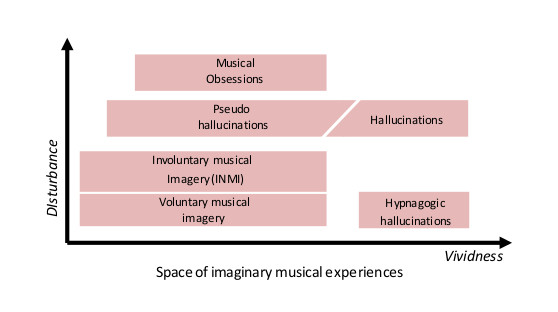There is a new topic in general psychology called involuntary musical imagery (INMI).1,2 It is of great potential interest to practitioners of clinical neuroscience because of its notable similarities to clinical involuntary music phenomena. INMI is defined as a conscious experience of reliving a musical memory without deliberately attempting to do so. It is also known by other colloquial names such as earworms, sticky tunes, or tune in the head phenomenon. In this paper I review recent empirical findings on the topic of involuntary music, highlighting how the findings from INMI research in the normal population1 may support the diagnosis of involuntary music in clinical practice.
It is proposed here that involuntary music involves a continuum of musical imagery phenomena, like the perceptual continuum proposed for hallucinatory perceptions.3 These phenomena range from common, “normal” involuntary music to pathological conditions (see Figure 1), such as musical obsessions,4 hallucinations,5 and palinacousis.6 This review includes involuntary phenomena from three disciplines: general psychology (specifically music), clinical neuroscience and psychodynamic psychology.

Involuntary music in general psychology
The human capacity to imagine sounds is generally called auditory imagery,7 and musical imagery when it involves music.8 Involuntary musical imagery is considered to be a manifestation of musical imagery7 with uncontrolled onset of imagery.9 This review is focused on INMI. As a subjective experience, INMI involves insight that the music is self-generated and its quality is not very vivid, in comparison to the perception of stimulus.
The first psychology paper related to INMI came out in 2004 when Kvavilashvili and Mandler10 reported a series of studies on involuntary semantic memories. Melodies were found to be the most frequently recurring memory type which people recall unintentionally. Since this seminal work, researchers have been interested in the frequency and duration of involuntary music,1,11 along with the phenomenology,1 triggers,2 and dynamics of INMI.9
There is a high prevalence of INMI in everyday life. An experience sampling study of musicology11 majors revealed that the students are deeply immersed in both voluntary and involuntary imagined music throughout the day. A questionnaire study of over 11,900 Finnish Internet users found that almost 90% of respondents experienced INMI every week (see Figure 2).1 In another recent study,a diary method was used for data collection over a four week period.12 The INMI episodes lasted 25 minutes in average and happened more than once a week.

The conscious experience of INMI varies considerably between people. For instance, despite the higher likelihood of certain songs being reported as INMI,the songs are very idiosyncratic overall.9 In the Beaman and Williams12 diary study, 74% of INMI reports involved a unique song. The songs can be old, contemporary, or even completely novel.1 Experiences of new, self-generated songs are more typical among musically-educated people.1,11 Features of the musical experience have also been examined. In the study of Finnish internet users,1 an INMI episode was typically contemporary, lyrical, and involved only a fraction of a song, presumably the chorus. The study found that the frequency and characteristics of the experience are influenced by age, gender and musical dispositions.Women reported experiences more often as did the younger cohorts.The frequency of musical activities correlated positively with the frequency of INMI experiences.
The causes of INMI are pretty much as yet unknown. The hypotheses often involve the func- tion of memory, in terms of enforcing and decaying activation in semantic memory networks.9,10 It is hypothesised that the activation of memory through recall, recognition, or cross- modal memory associations can evoke these experiences immediately or after a delay.A study of INMI triggers identified several common categories of triggers.2 Exposure to music, recent and repeated, was the most prominent category, but cross-modal associations to music, and affective states were also repeatedly mentioned by subjects. Further evidence about the role of memory activation comes from the only experimental study of INMI published thus far.9 Using a novel induction technique, it was found that the proportion of recently processed music among INMI reports increased in response to cueing. Familiarity with music was a necessary but not a sufficient condition for the emergence of INMI.The relative freshness of the song was important for its later induction, contemporary songs being more powerful cues than classic ones. The interpretation was that the repeated activation facilitates later, intentional or unintentional, imagination of music.
Involuntary music in clinical neuroscience
Several conditions in neurology and psychiatry involve symptoms very much like INMI, but are much more pronounced. For this review, I have included the most relevant phenomena with a known cause: peripheral nervous system, brain damage and functional diseases.13 Additionally, intoxication and epilepsy are known to sometimes trigger these symptoms.5 A rare phenomenon known as palinacousis has also been documented.6 It involves an auditory illusion of persistence of sound impressions after the cessation of the auditory stimulation, sometimes music. This condition is related to brain damage and epilepsy and should not be confused with other types of involuntary music.
Involuntary music is sometimes associated with obsessive-compulsive disorder (OCD) and schizophrenia. For OCD, so-called musical obsessions4,14 in the absence of other psychopathological symptoms, can be an adequate criterion for diagnosis when accompanied by subjective distress and dysfunction. For instance, Zungu-Dirway and colleagues4 described two patients who perceived the internally created music as intrusive, irritating and disruptive of other thought. The sole difference in the phenomenology of musical obsessions to INMI is their noticeable disruptiveness.
Hallucinations, including musical ones, are typical in schizophrenia. Musical hallucinations are more common than musical obsessions, even though they occur in less than 0.2% of hospital populations and typically involve elderly females.5 Among the researchers studying schizophrenia, there has been a long discussion about musical hallucinations and pseudo-hallucinations.15 For instance, Terao and Ikemura16 disagreed with the aforementioned musical obsessions diagnosis.4 They preferred to call the condition pseudo-hallucinations because the hallucinations (music) were perceived in the subjective space and were under limited conscious control.
Reduction or loss of hearing can trigger auditory hallucinations.5,17 This is sometimes called an auditory Charles Bonnet syndrome or auditory release hallucinations. The common denominator with these often elderly people is that their otherwise impoverished auditory consciousness becomes occupied with hallucinatory perceptions, in some cases music. Subjects usually have insight into the hallucinatory nature of their experiences. These conditions seem to relate to a lack of excitation to cortical auditory areas and limbic regions, as if the intact auditory cortices have become hypersensitive due to sensory deprivation.17 Brain damage or brain stimulation can alter normal musical processing and create involuntary music experiences. For instance, a brain stem lesion induced a temporary hearing loss and accompanying musical hallucinations in a middle- aged man.18
Involuntary music in psychodynamic psychology
Freud was known for his indifference to music, unlike many of his followers. For instance, Reik, a psychotherapist and a scholar, was convinced that involuntary musical memories had a function in the service of psychoanalysis.19 He believed that the INMI experiences of the analyst and the patient carried a hidden message about the workings of psyche, which the analyst could perceive and benefit from in the clinical work. Another hypothesis on the function of INMI portrays music as a substitute for the presence of a mothering person, comparing the role of music to the role of dreams in Freud’s theory. This idea finds some support in the trends of popular culture. Hannet20 studied the lyrical contents of 2111 “hit songs” from the first half of 20th century. Of those, 69% were classified as romantic love songs. The domination of love songs in the sample was interpreted as reflecting the universal need for love and passion, particularly that the popular lyrics express “unconscious infantile attitudes… or partial attachments to the image of preoedipal mother,” according to Hannett.20
Implications for practice
This review has illustrated involuntary music phenomena from harmless, common forms to troublesome clinical conditions. I proposed that there is a continuum3 of phenomena of involuntary music, with a variable degree of commonality and severity. It seems that the phenomenology of INMI and music-related mental disorders have much in common. INMI presents a case of intact self and reality monitoring (insight), but inadequate control of conscious thought. Regarding the latter, there is little evidence to support the sugges- tion that the use of mental coping strategies,12 for instance intentionally replacing an INMI song with another (musical displacement strategy), are effective in modulating the frequency, duration, or disruptiveness of INMI. An important characteristic of INMI is high inter-individual variability. Even though nearly everyone has experienced it, the frequency and the nature of the experience is different from person to person.1 It is note-worthy that the majority of people experiencing INMI several times a day find it compatible with everyday life.1,12 An interesting parallel between INMI1 and musical hallucinations13 is the female preponderance, although this is not characteristic of mental illness such as schizophrenia in general.For clinical practice,it is important to understand that even nearly constant, involuntary musical imagery may not indicate mental disorder if it does not impede everyday life. I believe future work on the topic is needed to clarify diagnostic criteria for OCD and schizophrenia to distinguish their features from “normal” INMI. Thus far, brain research techniques successfully used for imaging voluntary imagery and hallucinations have not been able to capture INMI, but we can hope future efforts will bring insights from the neural level to help diagnose involuntary music phenomena.
References
- Liikkanen LA. Musical activities predispose to involuntary musical imagery. Psychology of Music 2012;40(2):236-56.
- Williamson VJ, Jilka SR, Fry J, Finkel S, Müllensiefen D & Stewart L. How do “Earworms” Start? Classifying the everyday circumstances of involuntary musical imagery. Psychology of Music 2012;40(3):259-84.
- Vogeley K. Hallucinations emerge from an imbalance of self-monitoring and reality modelling. Monist 1999;82(4):626.
- Zungu-Dirwayi N, Hugo F, van Heerden BB & Stein DJ. Are musical obsessions a temporal lobe phenomenon? Journal Of Neuropsychiatry And Clinical Neurosciences 1999;11(3):398-400.
- Evers S & Ellger T. The clinical spectrum of musical hallucinations. Journal of the Neurological Sciences 2004;227(1):55-65.
- Podoll K. Musical palinacousis as an aura symptom. In: Neurology of music, ed. Rose, F.C. 2010; 221-35. London: Imperial College Press.
- Hubbard TL. Auditory imagery: Empirical findings. Psychol. Bull. 2010;136(2):302-29.
- Halpern AR & Zatorre RJ. When that tune runs through your head: A pet investigation of auditory imagery for familiar melodies. Cerebral Cortex 1999;9(7):697-704.
- Liikkanen LA. Inducing involuntary musical imagery: An experimental study. Musicae Scientiae 2012;16(2):217-34.
- Kvavilashvili L & Mandler G. Out of one’s mind: A study on involuntary semantic memories. Cognitive Psychology 2004;48(1):47-94.
- Bailes F. The prevalence and nature of imagined music in the everyday lives of musical students. Psychology of Music 2007;35(4):1-16.
- Beaman CP & Williams TI. Earworms (‘stuck song syndrome’): Towards a natural history of intrusive thoughts. British Journal of Psychology 2010;101(4):637–53.
- Berrios GE. Musical hallucinations. A historical and clinical study. The British Journal of Psychiatry 1990;156(2):188-94.
- Hermesh H, Konas S, Shiloh R, Dar R, Marom S, Weizman A & Gross-Isseroff R. Musical hallucinations: Prevalence in psychotic and nonpsychotic outpatients. Journal Of Clinical Psychiatry 2004;65(2):191-7.
- van der Zwaard R & Polak M A. Pseudohallucinations: A pseudoconcept? A review of the validity of the concept, related to associate symptomatology. Comprehensive Psychiatry 2001;42(1):42-50.
- Terao T & Ikemura N. Musical obsessions or hallucinations? Journal Of Neuropsychiatry And Clinical Neurosciences 2000;12(4):518-9.
- Griffiths TD. Musical hallucinosis in acquired deafness – phenomenology and brain substrate. Brain 2000;123(10):2065-76.
- Murata S, Naritomi H & Sawada T. Musical auditory hallucinations caused by a brainstem lesion. Neurology 1994;44(1):156.
- Reik T. The haunting melody: Psychoanalytic experiences in life and music, 1953; 380. New York: Farrar, Straus and Young.
- Hannett F. The haunting lyric – the personal and social significance of american popular songs. Psychoanalytic Quarterly. 1964;33:226-69.
